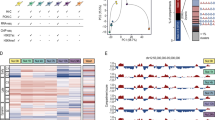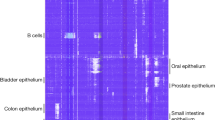Abstract
Nuclear receptor-binding SET domain protein 1 (NSD1) prototype is a family of mammalian histone methyltransferases (NSD1, NSD2/MMSET/WHSC1, NSD3/WHSC1L1) that are essential in development and are mutated in human acute myeloid leukemia (AML)1,2, overgrowth syndromes3, multiple myeloma4 and lung cancers5. In AML, the recurring t(5;11)(q35;p15.5) translocation fuses NSD1 to nucleoporin-98 (NUP98)6. Here, we present the first characterization of the transforming properties and molecular mechanisms of NUP98–NSD1. We demonstrate that NUP98–NSD1 induces AML in vivo, sustains self-renewal of myeloid stem cells in vitro, and enforces expression of the HoxA7, HoxA9, HoxA10 and Meis1 proto-oncogenes. Mechanistically, NUP98–NSD1 binds genomic elements adjacent to HoxA7 and HoxA9, maintains histone H3 Lys 36 (H3K36) methylation and histone acetylation, and prevents EZH2-mediated transcriptional repression of the Hox-A locus during differentiation. Deletion of the NUP98 FG-repeat domain, or mutations in NSD1 that inactivate the H3K36 methyltransferase activity or that prevent binding of NUP98–NSD1 to the Hox-A locus precluded both Hox-A gene activation and myeloid progenitor immortalization. We propose that NUP98–NSD1 prevents EZH2-mediated repression of Hox-A locus genes by colocalizing H3K36 methylation and histone acetylation at regulatory DNA elements. This report is the first to link deregulated H3K36 methylation to tumorigenesis and to link NSD1 to transcriptional regulation of the Hox-A locus.
This is a preview of subscription content, access via your institution
Access options
Subscribe to this journal
Receive 12 print issues and online access
$209.00 per year
only $17.42 per issue
Buy this article
- Purchase on Springer Link
- Instant access to full article PDF
Prices may be subject to local taxes which are calculated during checkout





Similar content being viewed by others
References
La Starza, R. et al. Cryptic insertion producing two NUP98/NSD1 chimeric transcripts in adult refractory anemia with an excess of blasts. Genes Chromosomes Cancer 41, 395–399 (2004).
Rosati, R. et al. NUP98 is fused to the NSD3 gene in acute myeloid leukemia associated with t(8;11)(p11.2;p15). Blood 99, 3857–3860 (2002).
Tatton-Brown, K. et al. Genotype-phenotype associations in Sotos syndrome: an analysis of 266 individuals with NSD1 aberrations. Am. J. Hum. Genet. 77, 193–204 (2005).
Keats, J. J. et al. Overexpression of transcripts originating from the MMSET locus characterizes all t(4;14)(p16;q32)-positive multiple myeloma patients. Blood 105, 4060–4069 (2005).
Tonon, G. et al. High-resolution genomic profiles of human lung cancer. Proc. Natl Acad. Sci. USA 102, 9625–9630 (2005).
Cerveira, N. et al. Frequency of NUP98–NSD1 fusion transcript in childhood acute myeloid leukaemia. Leukemia 17, 2244–2247 (2003).
Sauvageau, G. et al. Differential expression of homeobox genes in functionally distinct CD34+ subpopulations of human bone marrow cells. Proc. Natl Acad. Sci. USA 91, 12223–12227 (1994).
Thorsteinsdottir, U. et al. Overexpression of the myeloid leukemia-associated Hoxa9 gene in bone marrow cells induces stem cell expansion. Blood 99, 121–129 (2002).
Lawrence, H. J. et al. Frequent co-expression of the HOXA9 and MEIS1 homeobox genes in human myeloid leukemias. Leukemia 13, 1993–1999 (1999).
Afonja, O. et al. MEIS1 and HOXA7 genes in human acute myeloid leukemia. Leuk. Res. 24, 849–855 (2000).
Kroon, E. et al. Hoxa9 transforms primary bone marrow cells through specific collaboration with Meis1a but not Pbx1b. EMBO J. 17, 3714–3725 (1998).
Wang, G. G., Pasillas, M. P. & Kamps, M. P. Persistent transactivation by meis1 replaces hox function in myeloid leukemogenesis models: evidence for co-occupancy of meis1–pbx and hox–pbx complexes on promoters of leukemia-associated genes. Mol. Cell Biol. 26, 3902–3916 (2006).
Hess, J. L. MLL: a histone methyltransferase disrupted in leukemia. Trends Mol. Med. 10, 500–507 (2004).
Wysocka, J. et al. WDR5 associates with histone H3 methylated at K4 and is essential for H3 K4 methylation and vertebrate development. Cell 121, 859–872 (2005).
Dou, Y. et al. Physical association and coordinate function of the H3 K4 methyltransferase MLL1 and the H4 K16 acetyltransferase MOF. Cell 121, 873–885 (2005).
Yokoyama, A. et al. The menin tumor suppressor protein is an essential oncogenic cofactor for MLL-associated leukemogenesis. Cell 123, 207–218 (2005).
Okada, Y. et al. hDOT1L links histone methylation to leukemogenesis. Cell 121, 167–178 (2005).
Okada, Y. et al. Leukaemic transformation by CALM–AF10 involves upregulation of Hoxa5 by hDOT1L. Nature Cell Biol. 8, 1017–1024 (2006).
Milne, T. A., Martin, M. E., Brock, H. W., Slany, R. K. & Hess, J. L. Leukemogenic MLL fusion proteins bind across a broad region of the Hox a9 locus, promoting transcription and multiple histone modifications. Cancer Res. 65, 11367–11374 (2005).
Kasper, L. H. et al. CREB binding protein interacts with nucleoporin-specific FG repeats that activate transcription and mediate NUP98–HOXA9 oncogenicity. Mol. Cell Biol. 19, 764–776 (1999).
Rayasam, G. V. et al. NSD1 is essential for early post-implantation development and has a catalytically active SET domain. EMBO J. 22, 3153–3163 (2003).
Pokholok, D. K. et al. Genome-wide map of nucleosome acetylation and methylation in yeast. Cell 122, 517–527 (2005).
Xiao, T. et al. Phosphorylation of RNA polymerase II CTD regulates H3 methylation in yeast. Genes Dev. 17, 654–663 (2003).
Tompa, R. & Madhani, H. D. Histone H3 lysine 36 methylation antagonizes silencing in Saccharomyces cerevisiae independently of the Rpd3S histone deacetylase complex. Genetics 175, 585–593 (2007).
Carrozza, M. J. et al. Histone H3 methylation by Set2 directs deacetylation of coding regions by Rpd3S to suppress spurious intragenic transcription. Cell 123, 581–592 (2005).
Zhao, Z., Yu, Y., Meyer, D., Wu, C. & Shen, W. H. Prevention of early flowering by expression of FLOWERING LOCUS C requires methylation of histone H3 K36. Nature Cell Biol. 7, 1256–1260 (2005).
Bender, L. B. et al. MES-4: an autosome-associated histone methyltransferase that participates in silencing the X chromosomes in the C. elegans germ line. Development 133, 3907–3917 (2006).
Fong, Y., Bender, L., Wang, W. & Strome, S. Regulation of the different chromatin states of autosomes and X chromosomes in the germ line of C. elegans. Science 296, 2235–2238 (2002).
Wang, G. G., Pasillas, M. P. & Kamps, M. P. Meis1 programs transcription of FLT3 and cancer stem cell character, using a mechanism that requires interaction with PBX and a novel function of the Meis1 C-terminus. Blood 106, 254–264 (2005).
Wang, G. G. et al. Quantitative production of macrophages or neutrophils ex vivo using conditional Hoxb8. Nature Methods 3, 287–293 (2006).
Zeisig, B. B. et al. Hoxa9 and Meis1 are key targets for MLL-ENL-mediated cellular immortalization. Mol. Cell Biol. 24, 617–628 (2004).
Cao, R. & Zhang, Y. SUZ12 is required for both the histone methyltransferase activity and the silencing function of the EED–EZH2 complex. Mol. Cell 15, 57–67 (2004).
Cha, T. L. et al. Akt-mediated phosphorylation of EZH2 suppresses methylation of lysine 27 in histone H3. Science 310, 306–310 (2005).
Wysocka, J. et al. A PHD finger of NURF couples histone H3 lysine 4 trimethylation with chromatin remodelling. Nature 442, 86–90 (2006).
Shi, X. et al. ING2 PHD domain links histone H3 lysine 4 methylation to active gene repression. Nature 442, 96–99 (2006).
Acknowledgements
This work is supported by Public Health Service grant NIH CA56876 awarded to M.P.K. We thank D. Young for assistance with FACS analysis, J. Aguilera for assistance with mouse radiation and C. Yost for assistance with haematological analysis (UCSD Cancer Center Shared Resources). Special thanks to P. Chambon, J. Van Deursen and R. Slany for providing plasmids and antibodies. We also thank J.-L. Luo and S. Zhang for helping with bone marrow transplantation and fluorescence microscopy.
Author information
Authors and Affiliations
Corresponding author
Ethics declarations
Competing interests
The authors declare no competing financial interests.
Supplementary information
Supplementary Information
Supplementary figures S1, S2, S3, S4 and Supplementary table S1 (PDF 442 kb)
Rights and permissions
About this article
Cite this article
Wang, G., Cai, L., Pasillas, M. et al. NUP98–NSD1 links H3K36 methylation to Hox-A gene activation and leukaemogenesis. Nat Cell Biol 9, 804–812 (2007). https://doi.org/10.1038/ncb1608
Received:
Accepted:
Published:
Issue Date:
DOI: https://doi.org/10.1038/ncb1608
This article is cited by
-
Regulation of HOX gene expression in AML
Blood Cancer Journal (2024)
-
Phase separations in oncogenesis, tumor progressions and metastasis: a glance from hallmarks of cancer
Journal of Hematology & Oncology (2023)
-
NUP98::Nsd1 and FLT3-ITD collaborate to generate acute myeloid leukemia
Leukemia (2023)
-
H3K36 methylation maintains cell identity by regulating opposing lineage programmes
Nature Cell Biology (2023)
-
The Nup98::Nsd1 fusion gene induces CD123 expression in 32D cells
International Journal of Hematology (2023)



